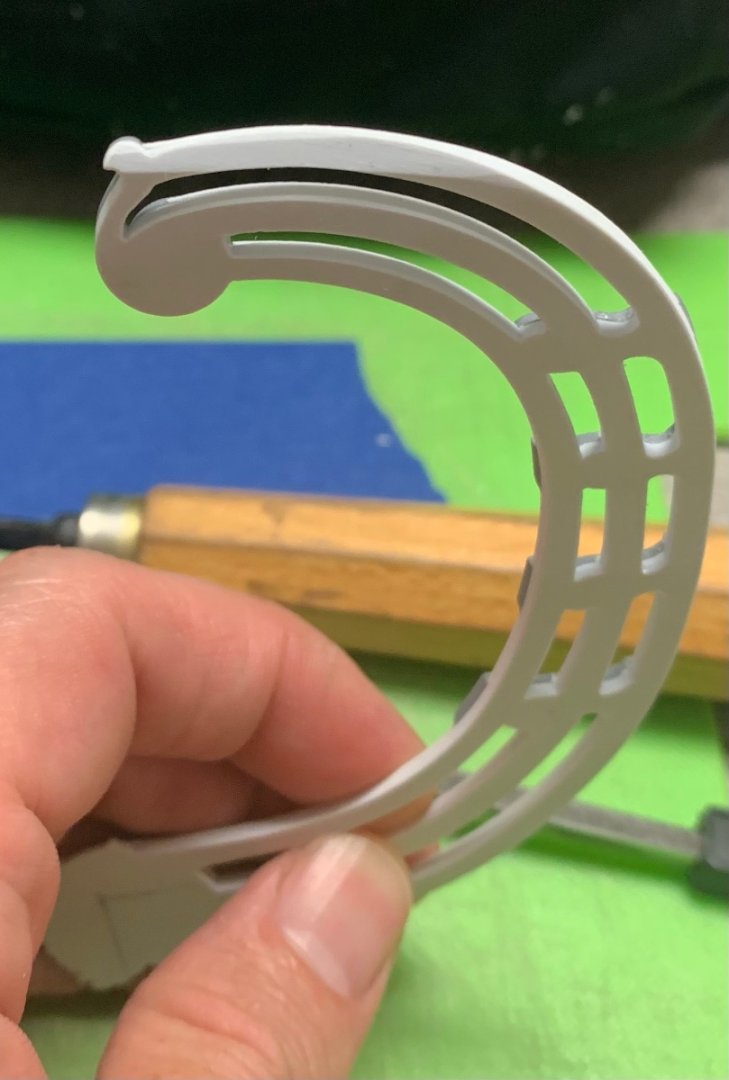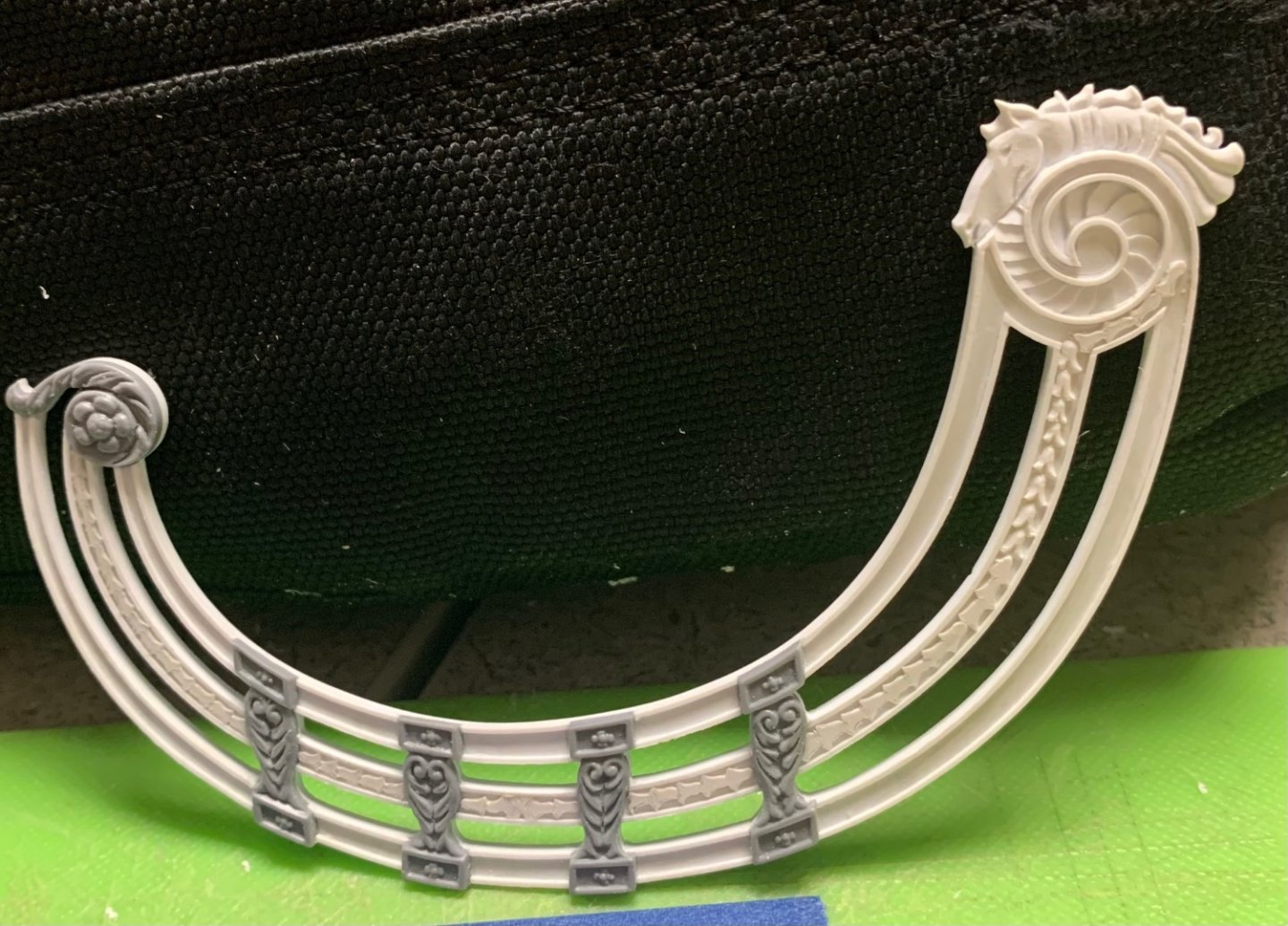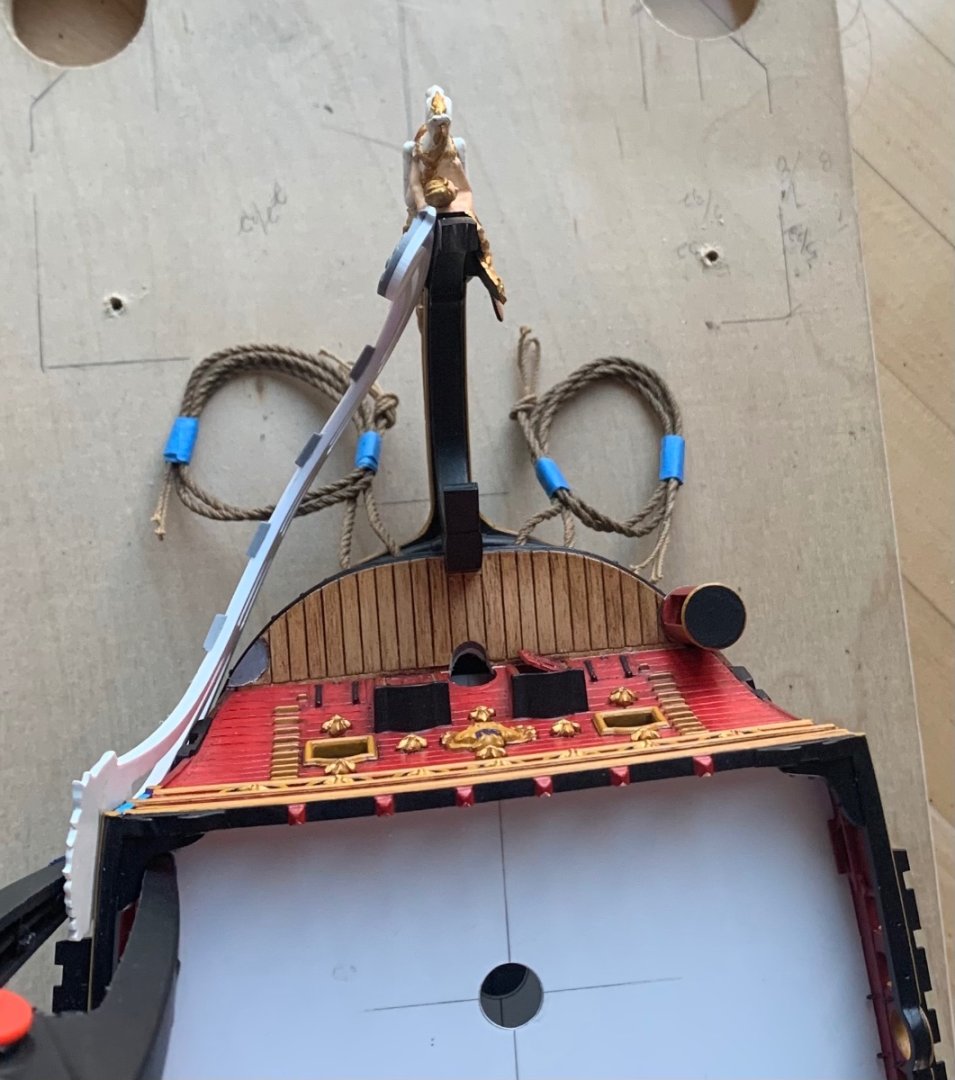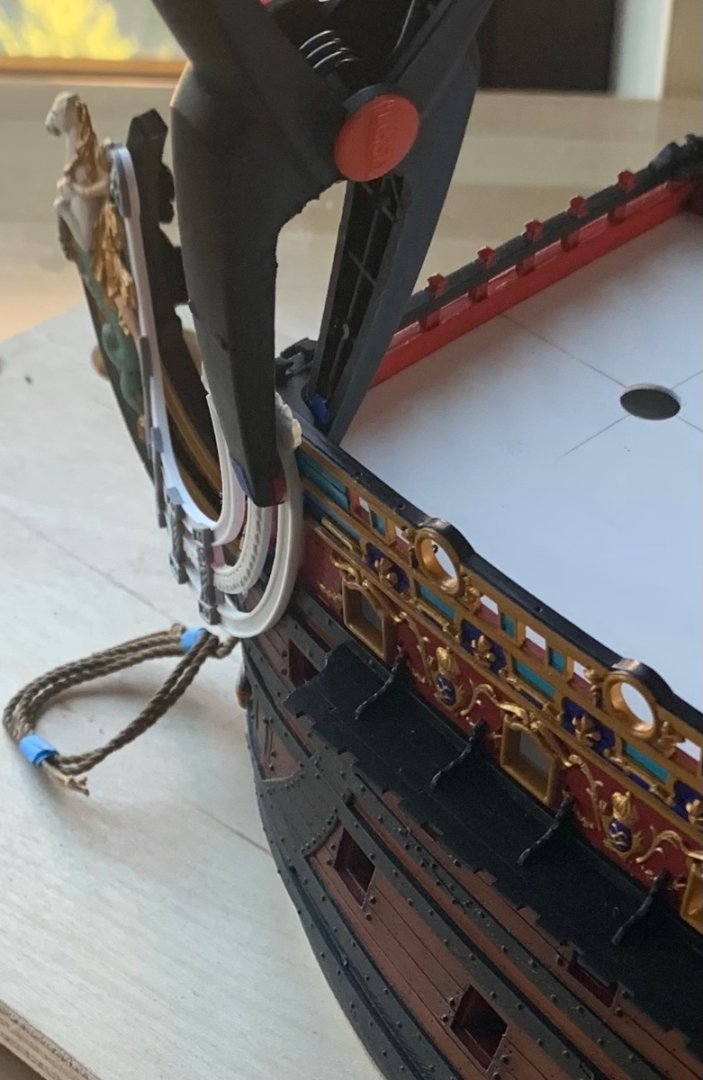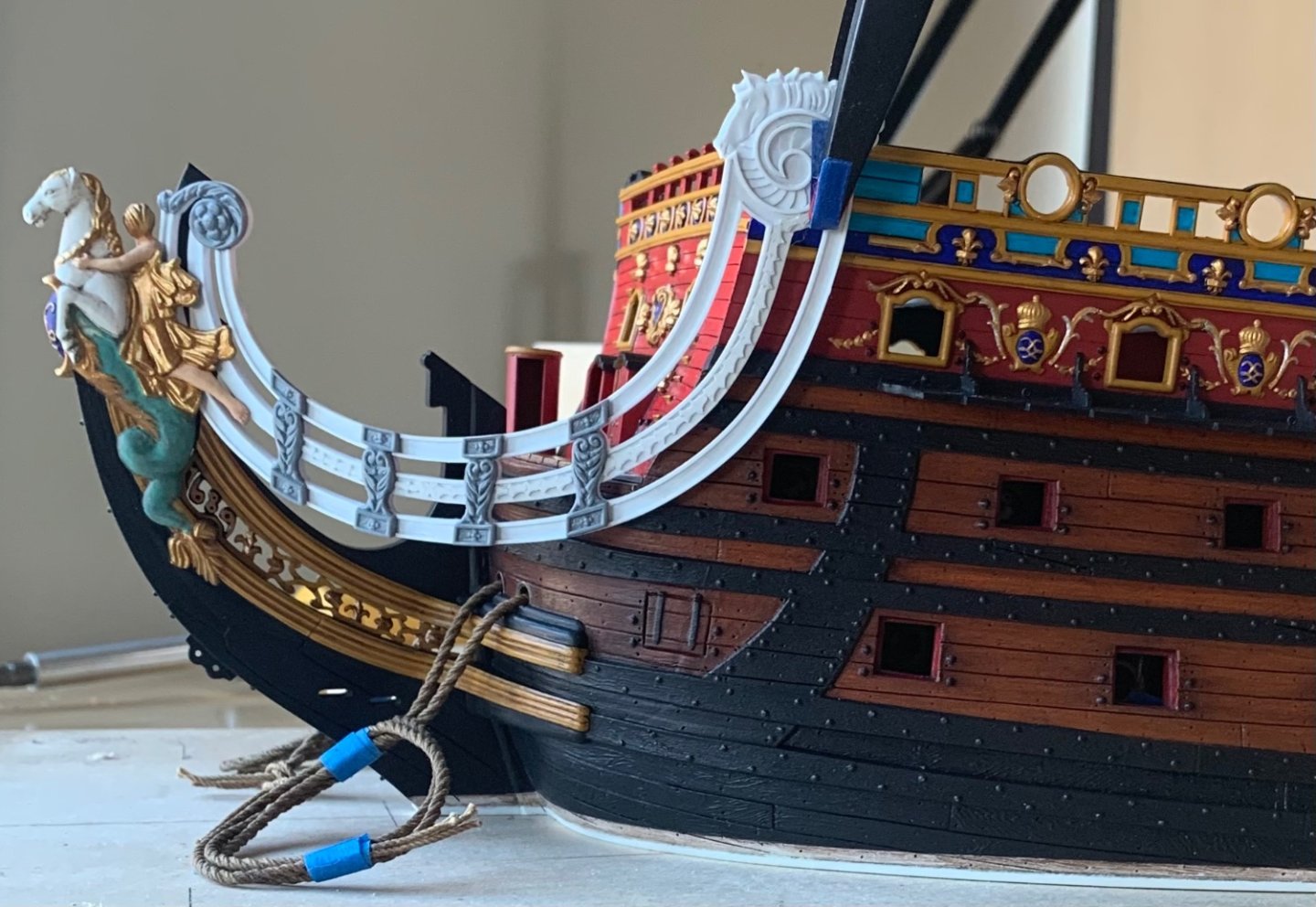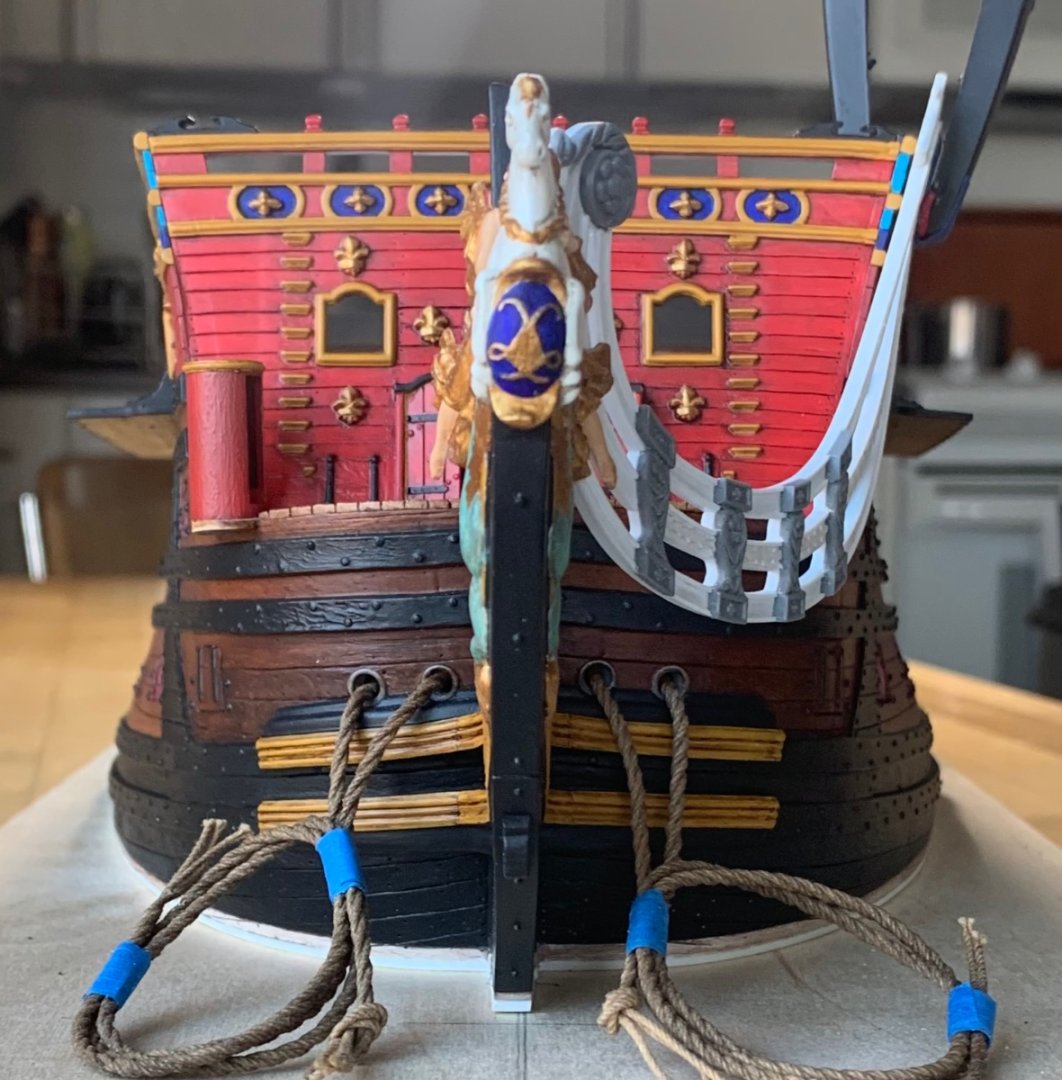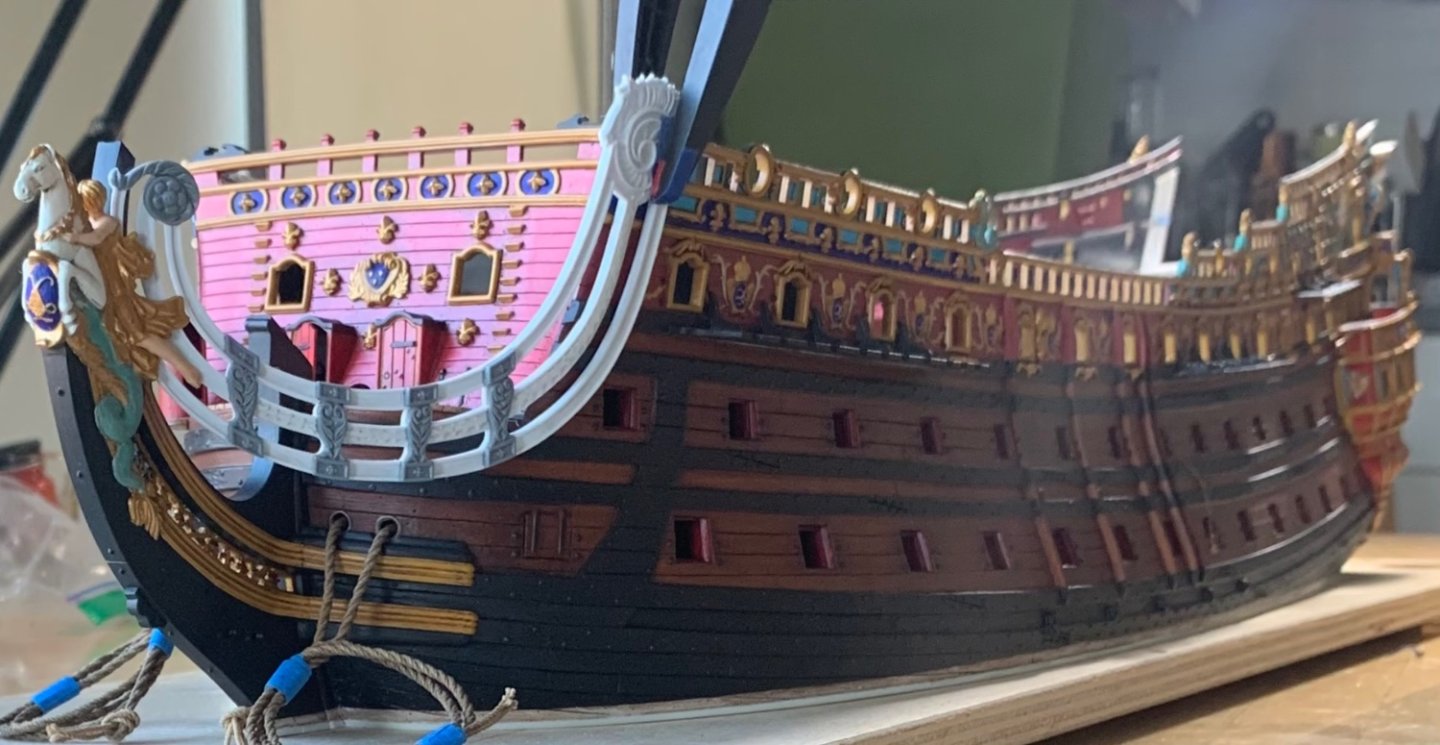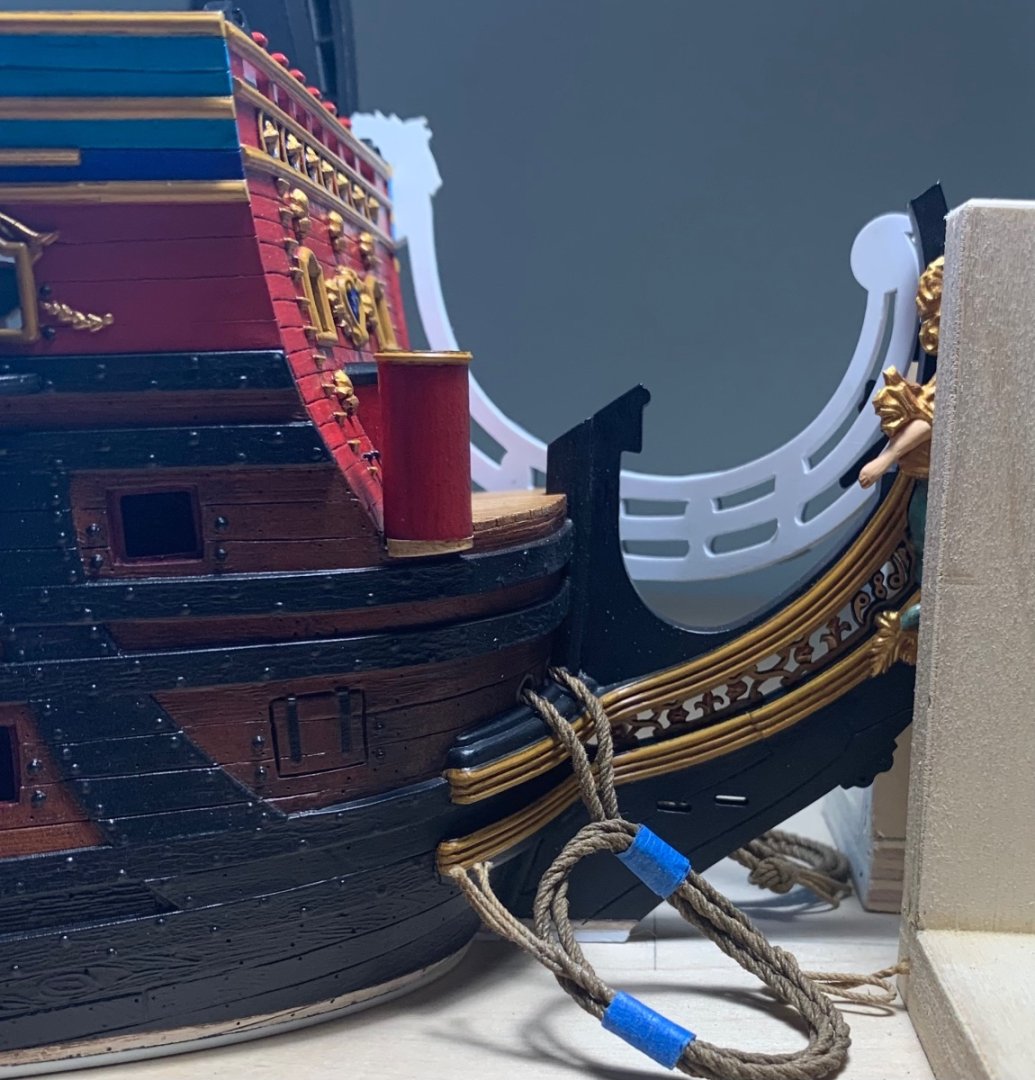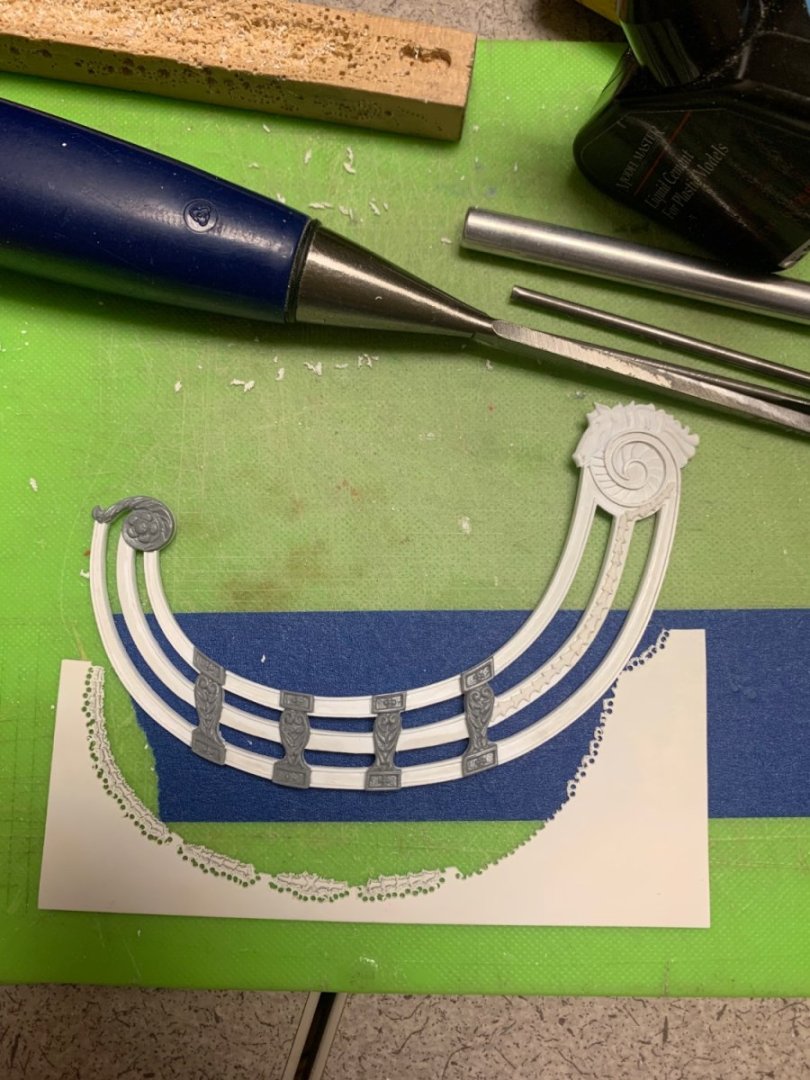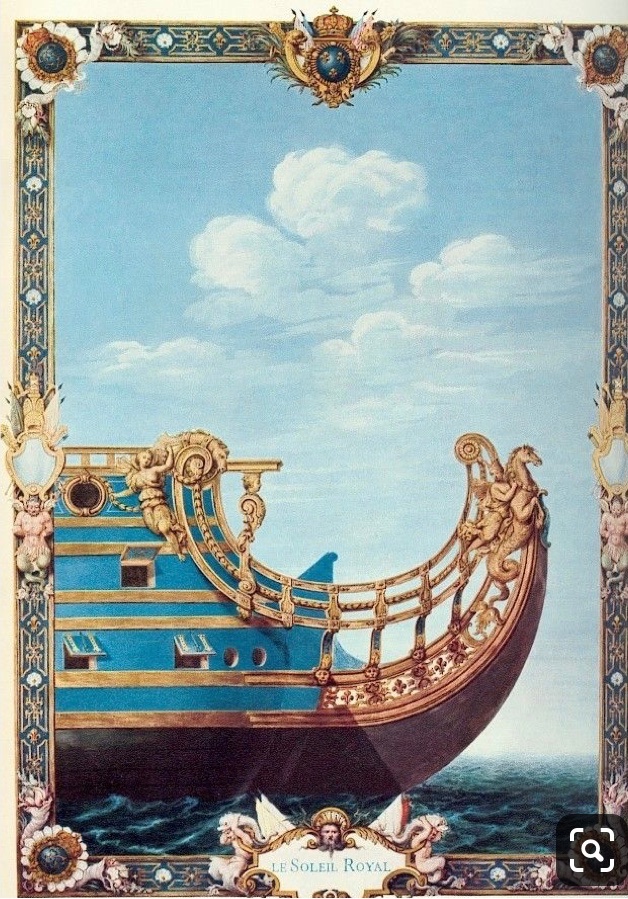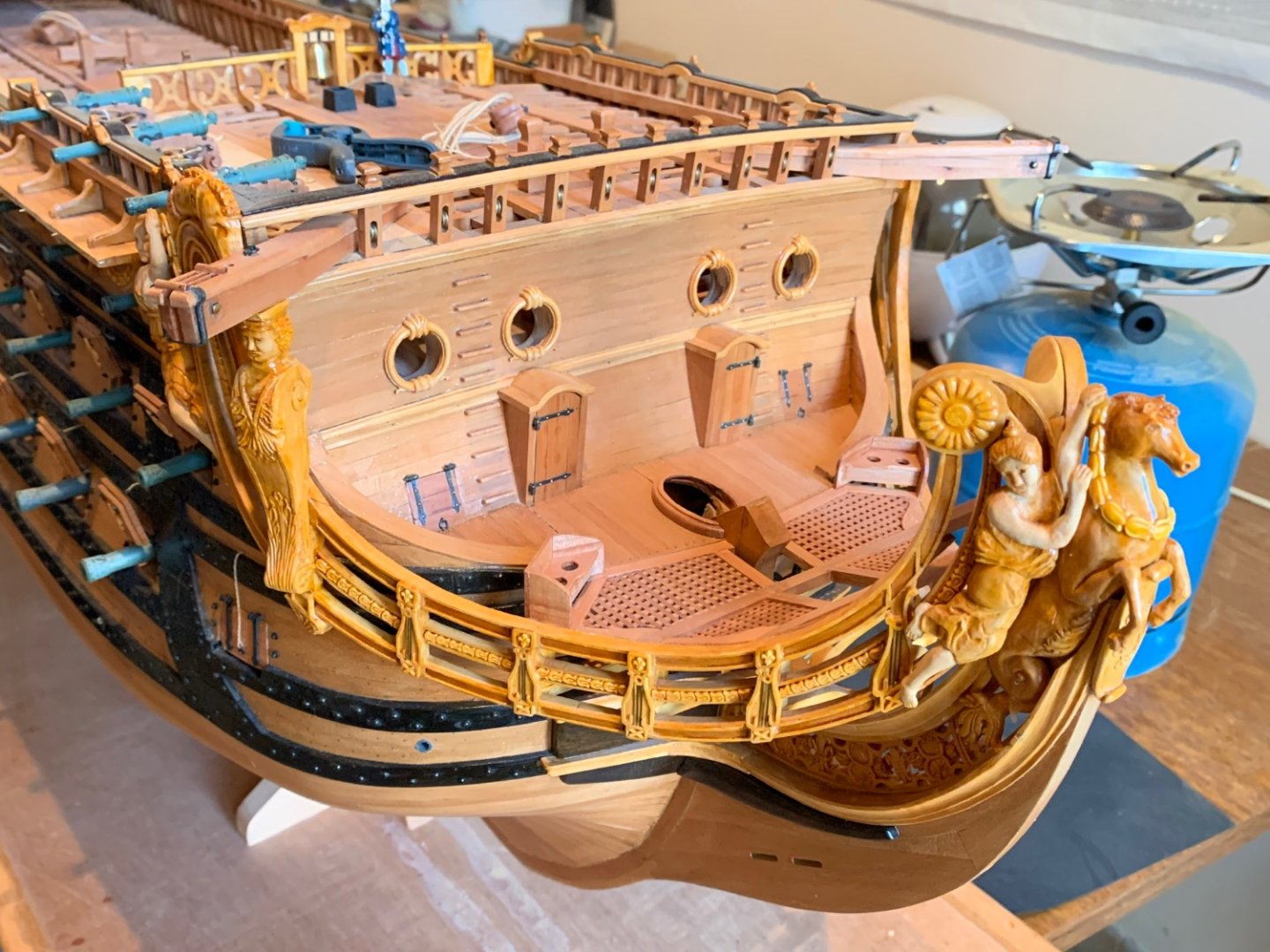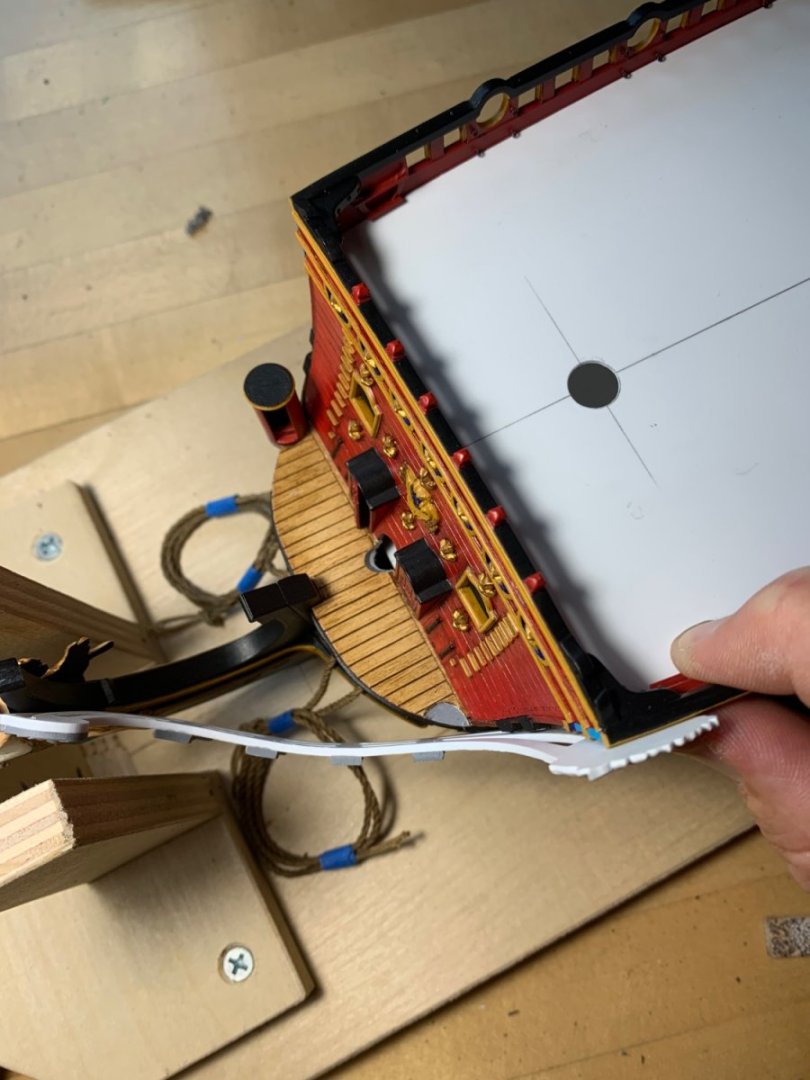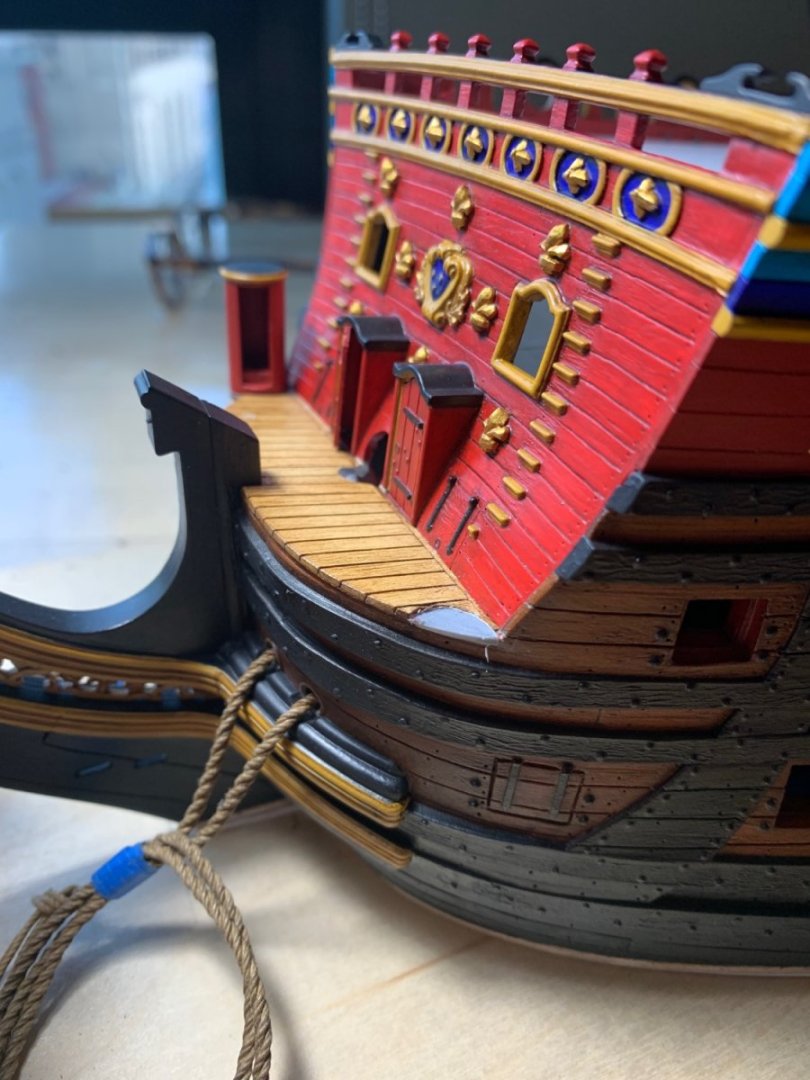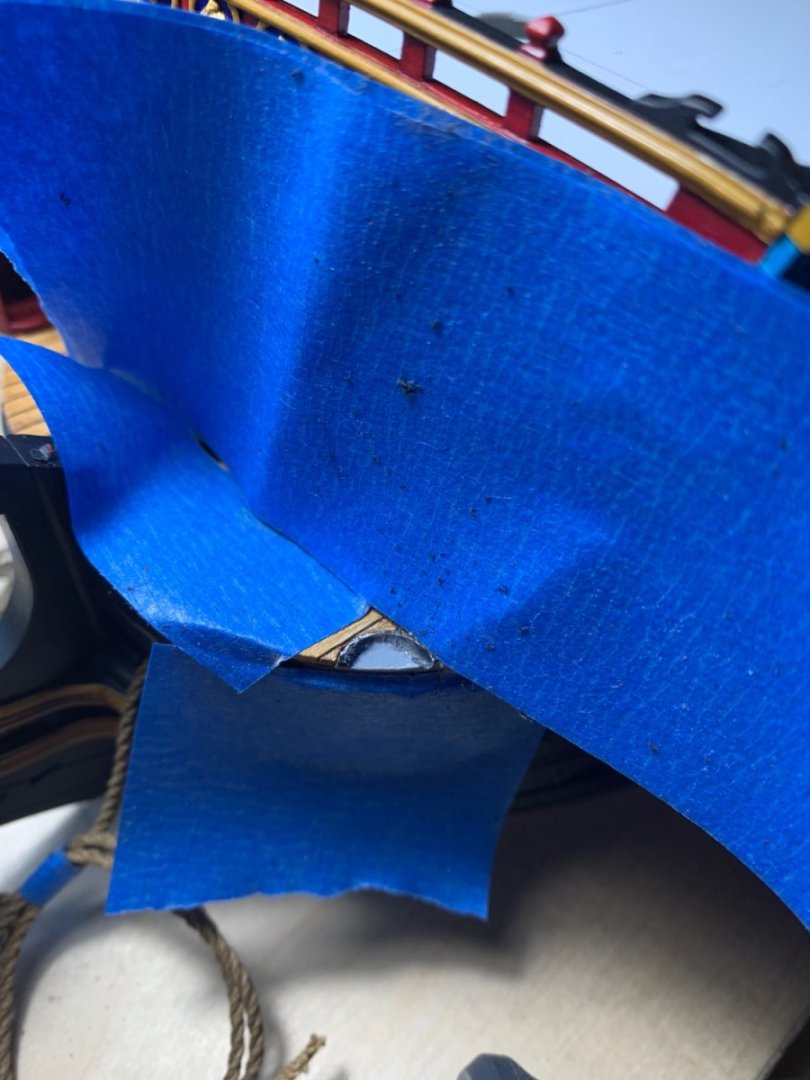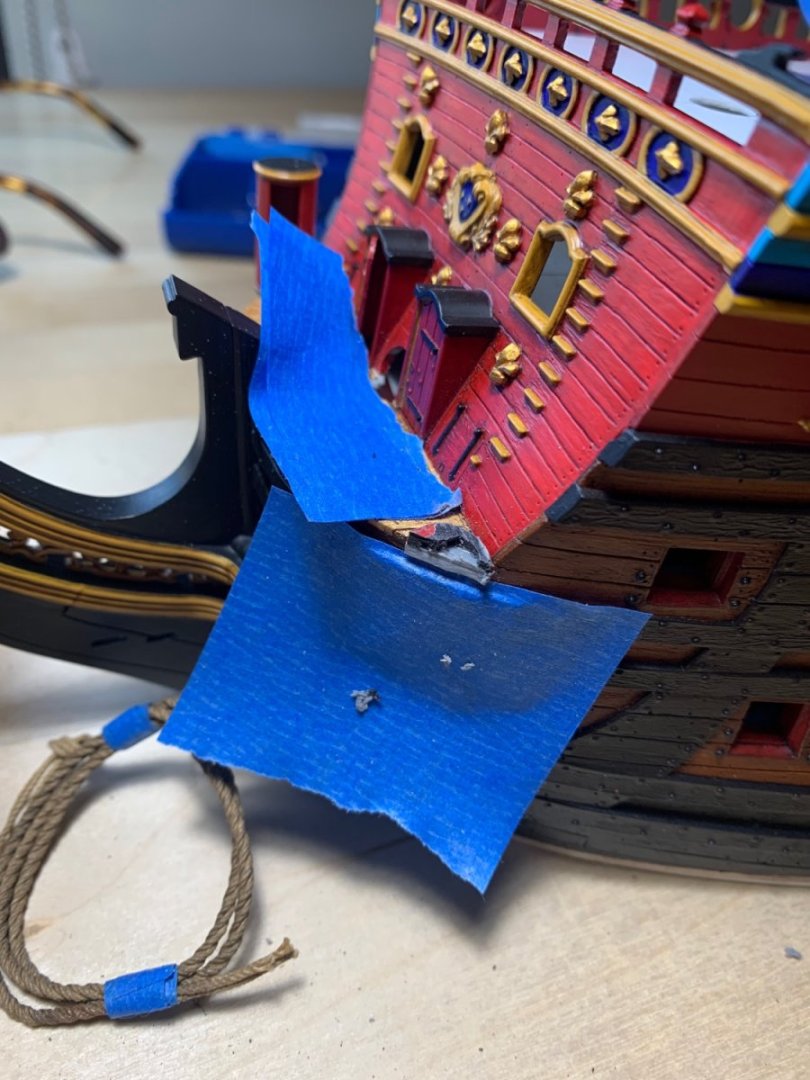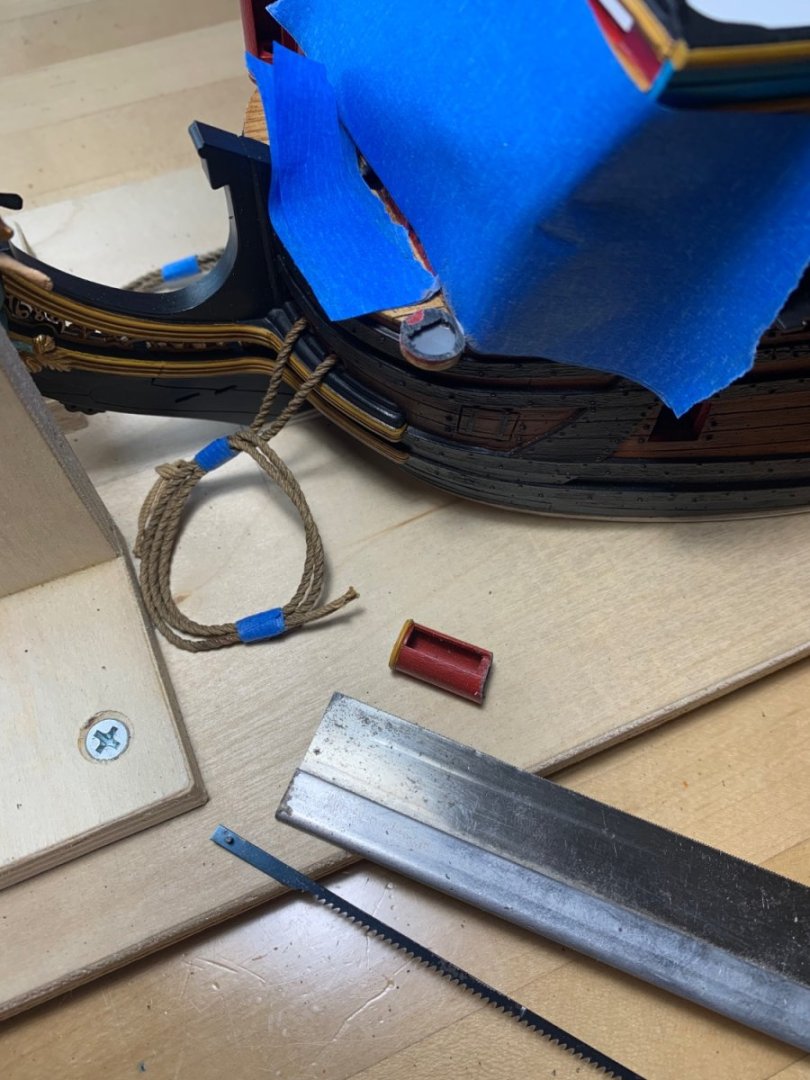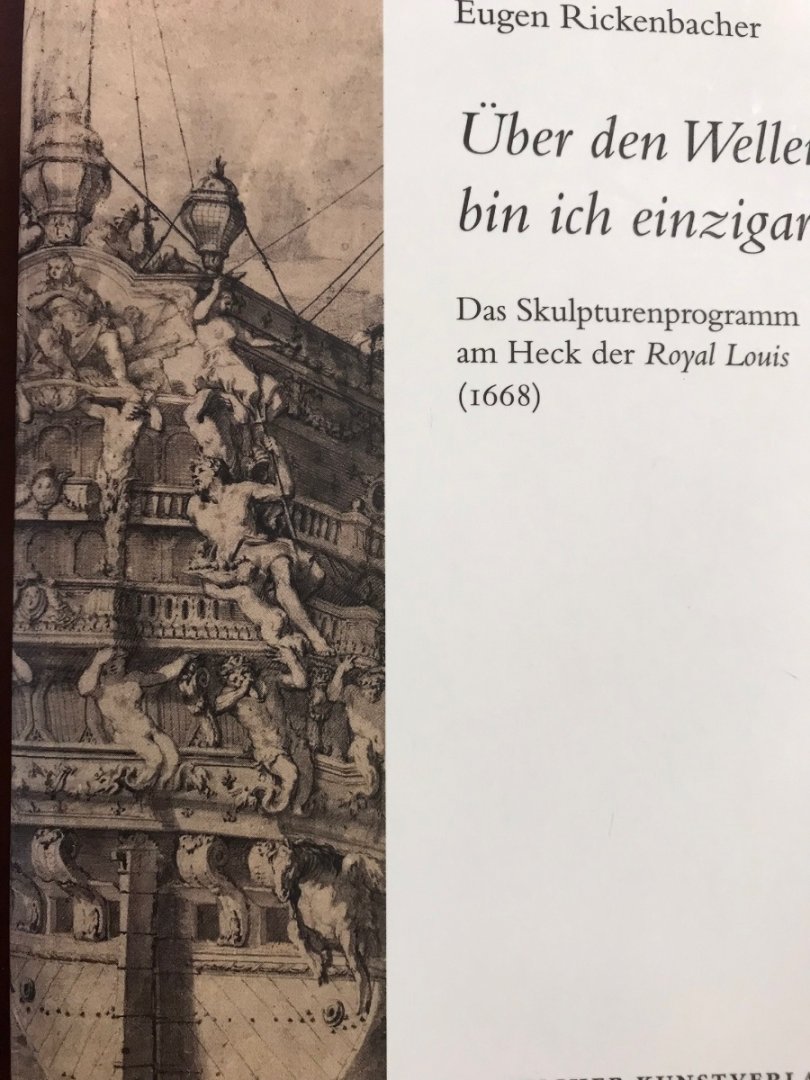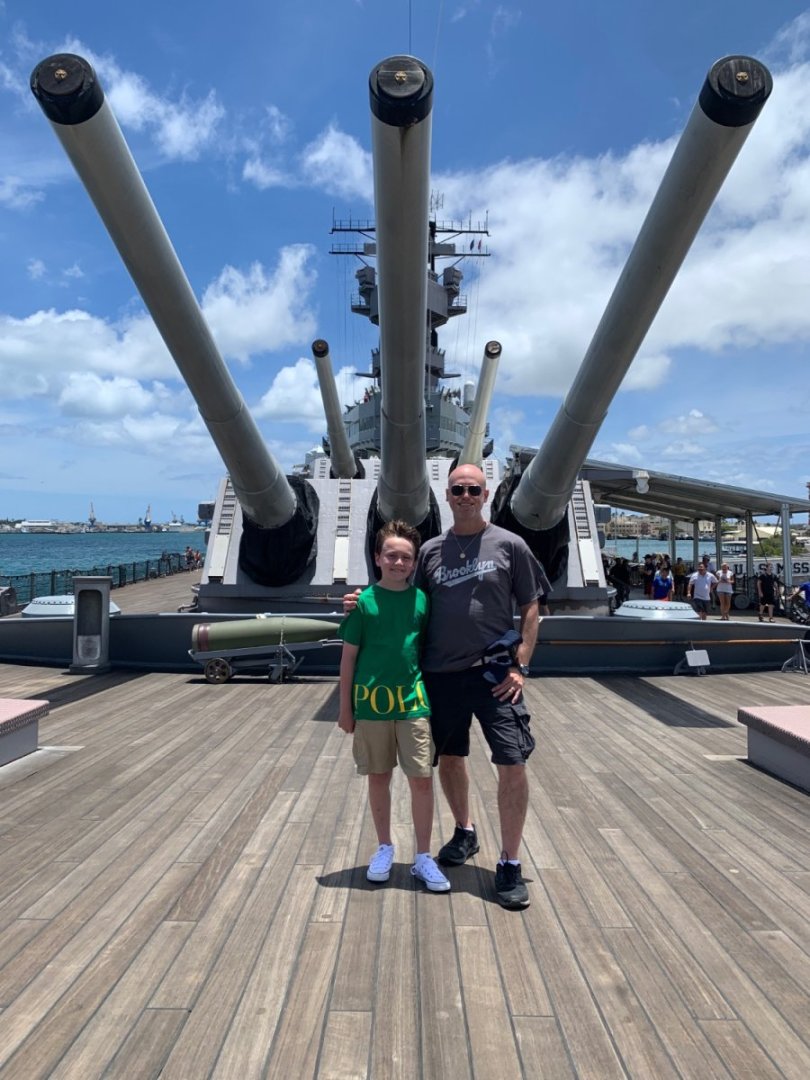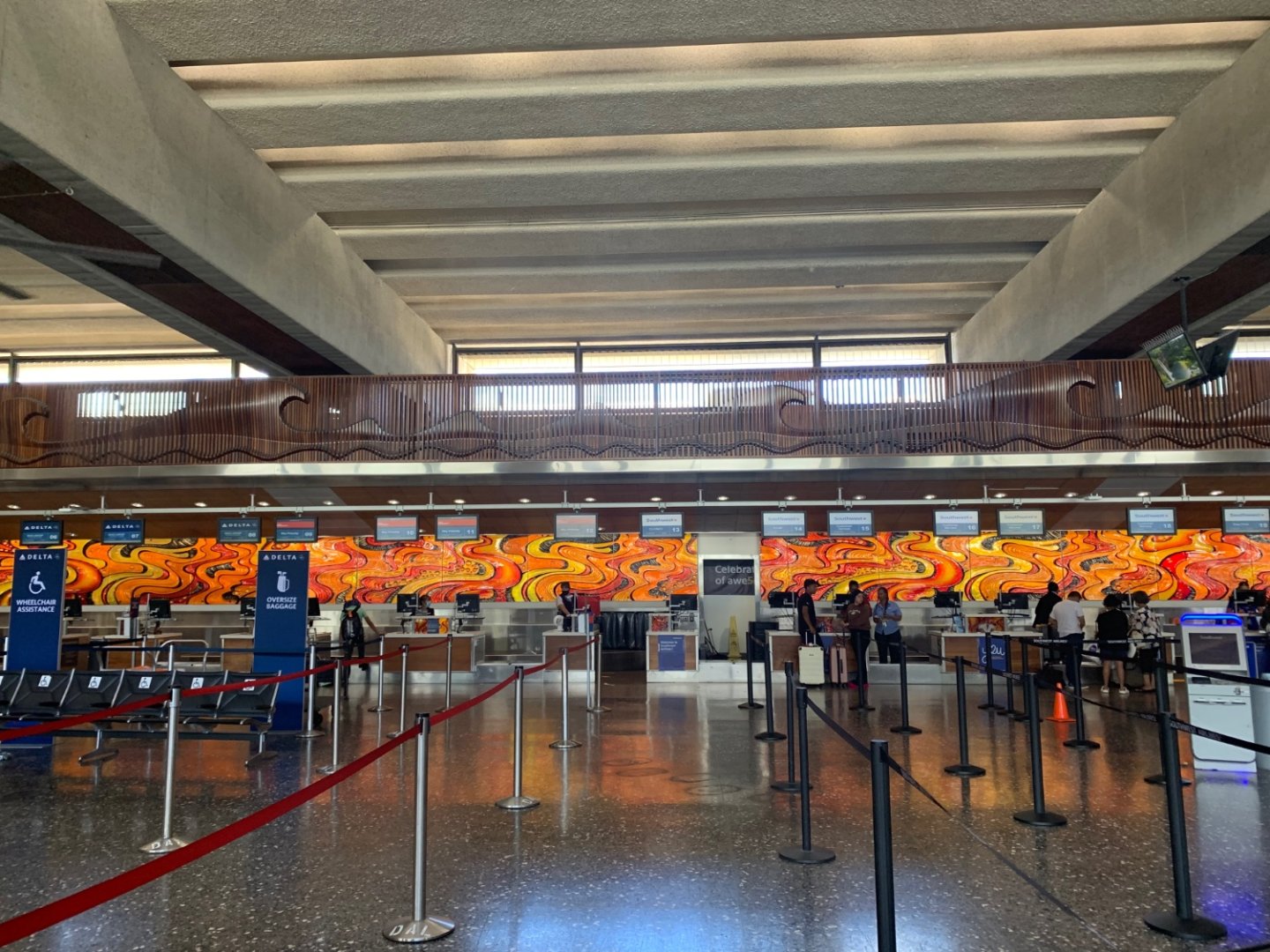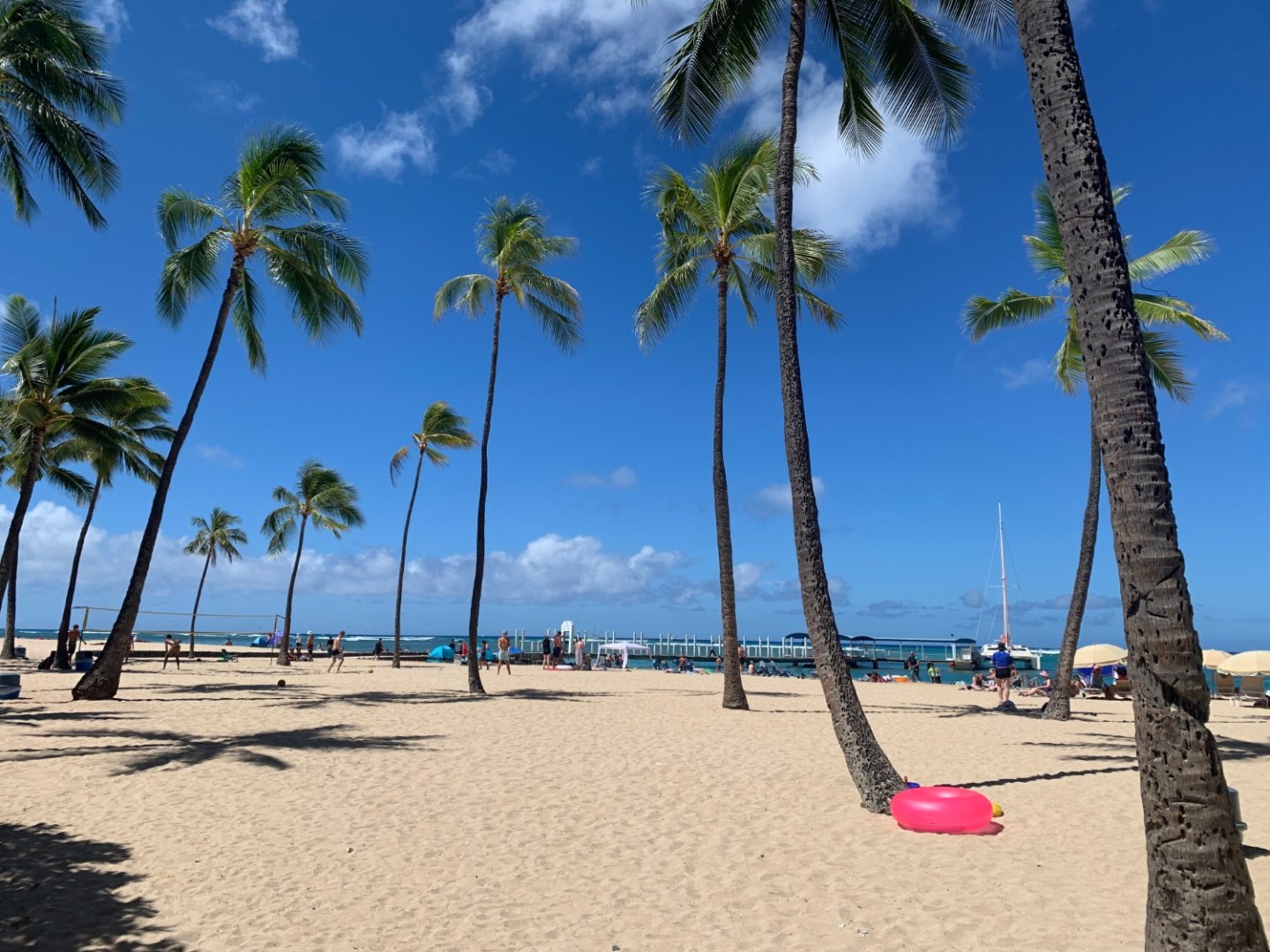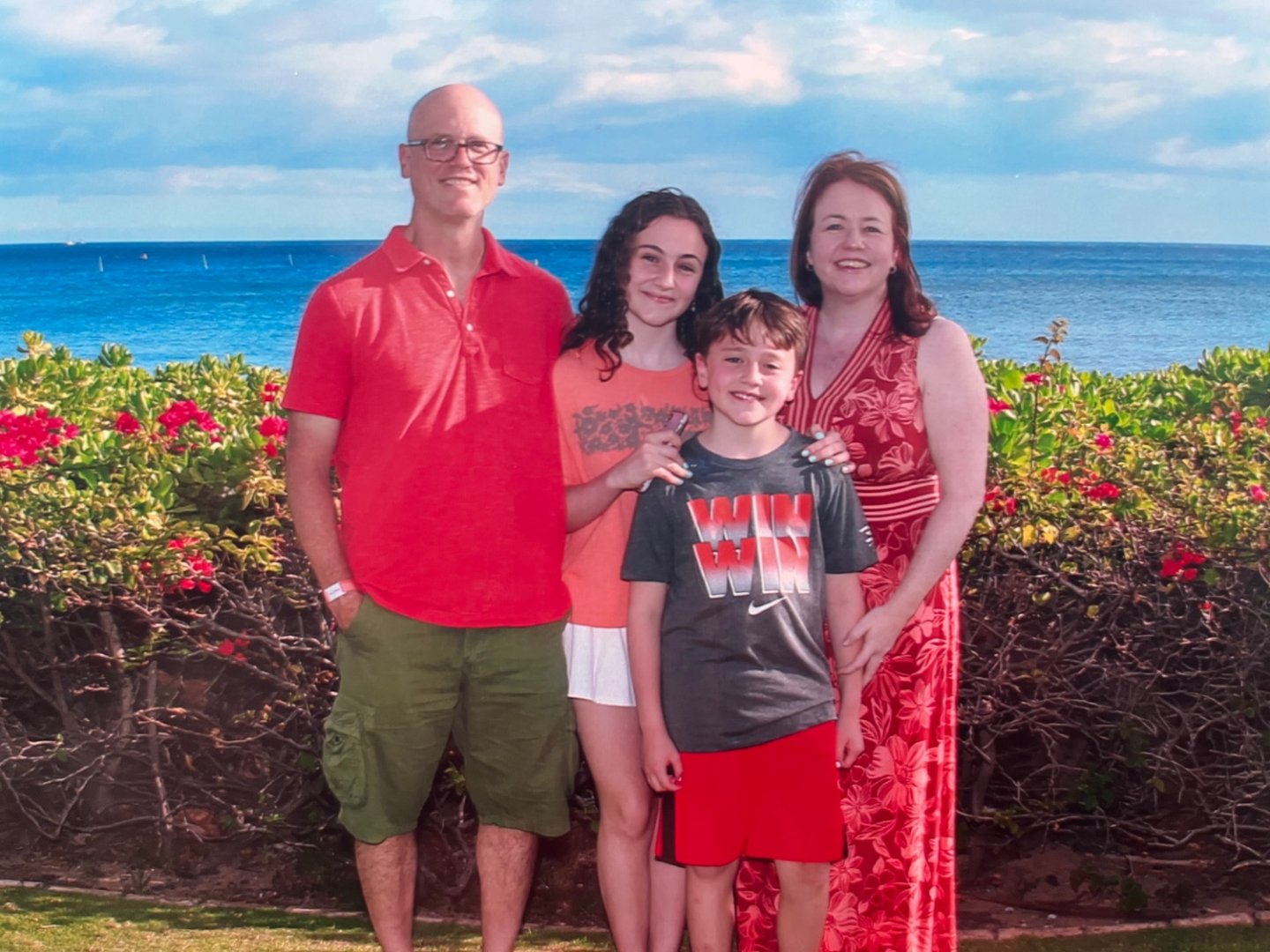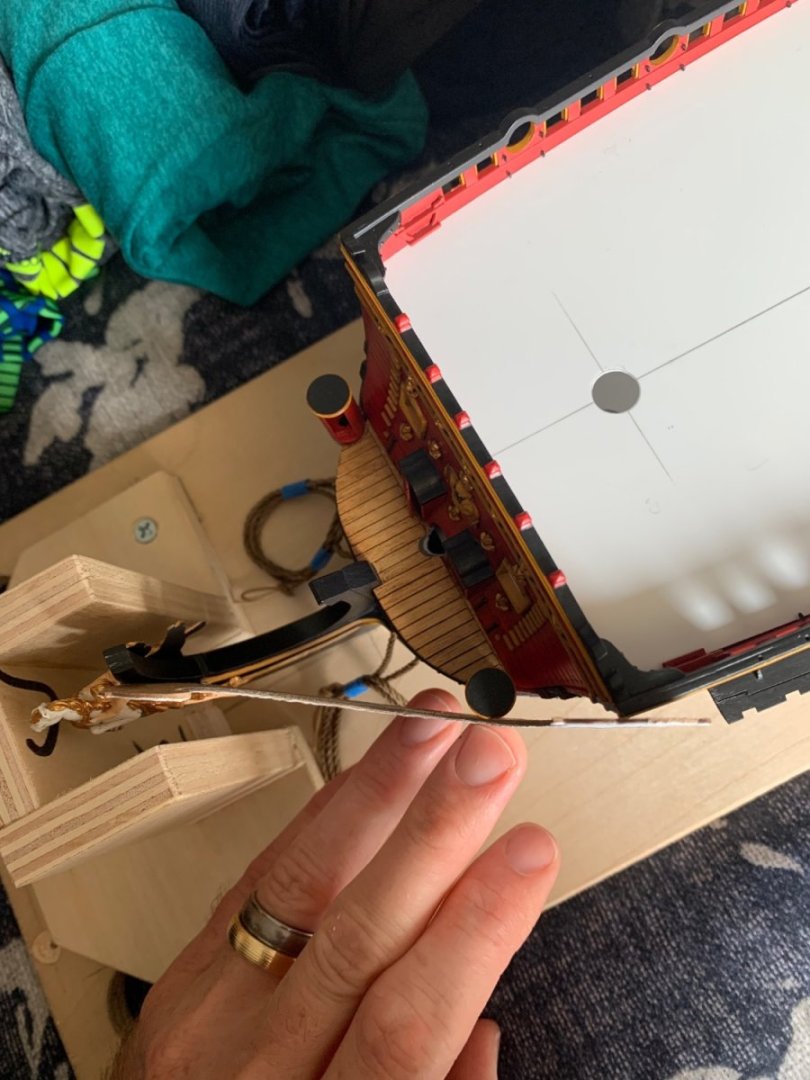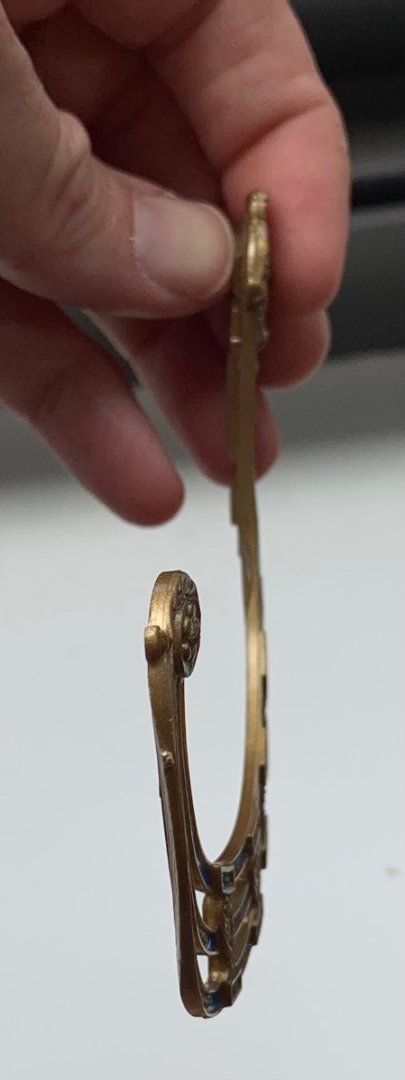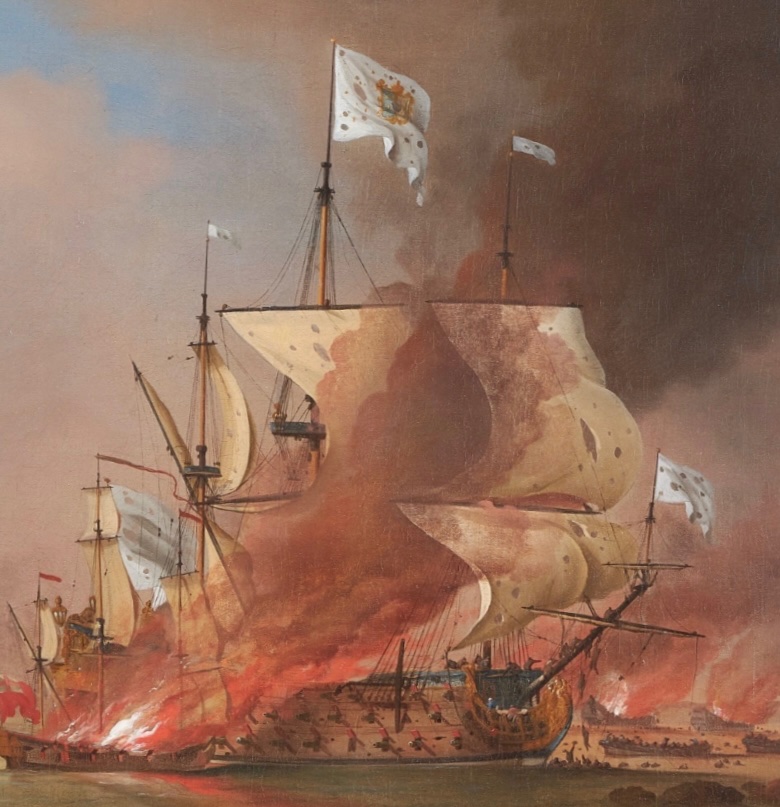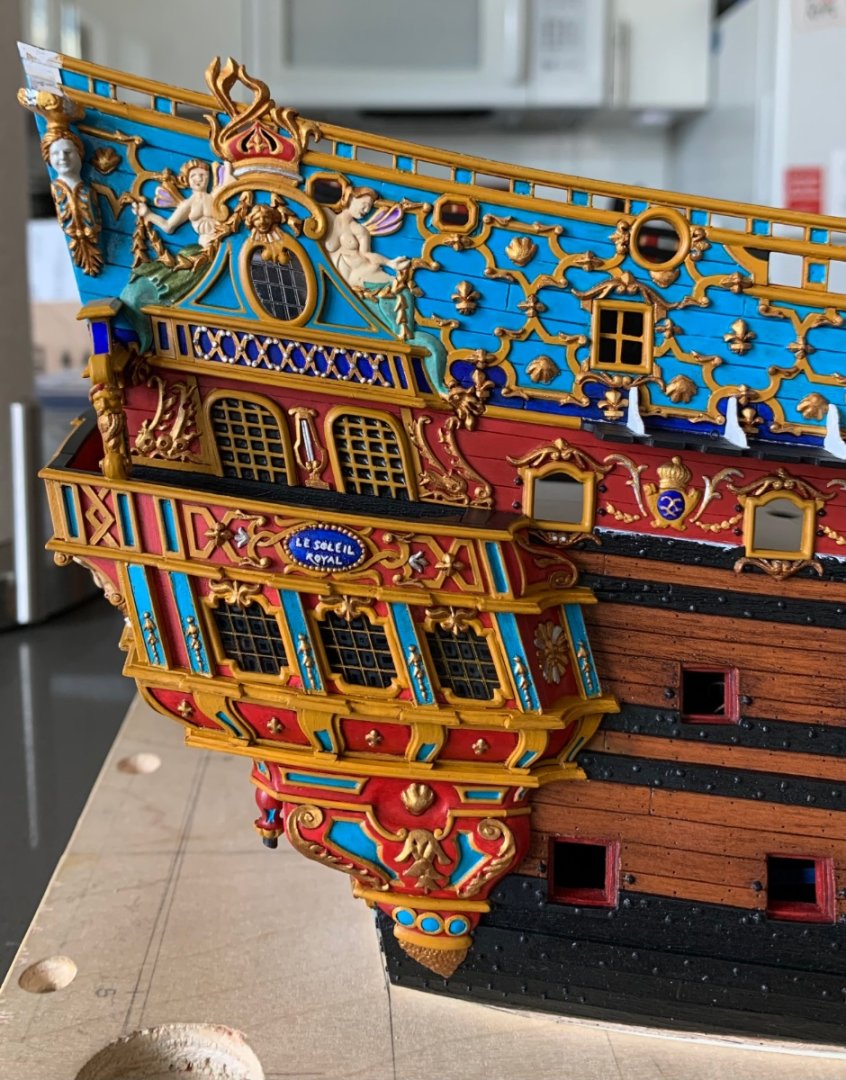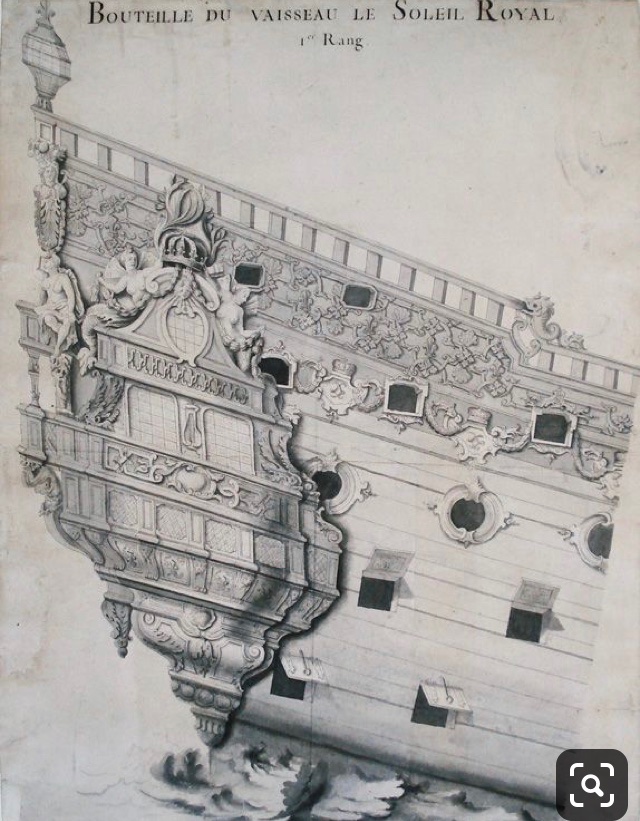-
Posts
2,950 -
Joined
-
Last visited
Content Type
Profiles
Forums
Gallery
Events
Everything posted by Hubac's Historian
-
What impresses me most is the work you did at the bow. Somehow, you appear to have re-cycled the middle gallery railing into your trailboard to brilliant effect. It looks like it grew there. You also managed a very nice sweep to the transverse supporting timbers of the headrails. My supposition, here, is that Nek0's lines lowered the knee of the head, allowing a little more clearance beneath the headrails. Did you also move the turreted head seats a little further in-board? As you are well aware, these are all of the difficult problems I've been trying to suss-through myself. I also really like your decking; the shift pattern and nailing look very realistic with appropriately spaced beams. It really is incredible to me that you started this whole thing just a couple of months ago, and it has all come together so beautifully.
-
Well, it sounds like good things are happening in her life. Doris looks happy and healthy!
- 1,035 replies
-
- royal katherine
- ship of the line
-
(and 1 more)
Tagged with:
-
This is very high praise coming from a person who’s work I very much admire - thank you B.E.!
- 2,444 replies
-
- heller
- soleil royal
-
(and 9 more)
Tagged with:
-
Absolutely, when it comes to scraps of plastic and off-cuts from nice furniture projects; one never knows when they may have to splice a dutchman with perfectly matching color and grain - kids being kids, and all. I do at least go through my plastic scraps and use the just big enough piece for the next little thing I’m making.
-
One of the most brilliant talents out there. I hope she is well and looking for her next inspiration.
- 1,035 replies
-
- royal katherine
- ship of the line
-
(and 1 more)
Tagged with:
-
Really beautiful work, overall. I love the mast detailing.
- 858 replies
-
- Sphinx
- Vanguard Models
-
(and 1 more)
Tagged with:
-
Thank you very much, Dan! You know, Druxey, I can see a path toward what you are suggesting, but I have too much time invested in them to risk messing them up for a 1/16” gain. These horse carvings will look good leaping over the beakhead rail.
- 2,444 replies
-
- heller
- soleil royal
-
(and 9 more)
Tagged with:
-
Well, Ian, thank you! I have been known to practice a little home dentistry, when necessary, so I suppose those abilities see some light of day. There hasn’t been a whole lot of time to put into the ship this past week, as a dear friend from Sweden has been visiting. It has been an extremely social and active time for me. I have managed to continue detailing the port headrails. This is very time consuming because all of these fine border mouldings have to be cut and fit by hand. I decided that the best course for the middle rail was to affix the top moulding and leave the bottom moulding off until I had fit and secured each section of the bellflower garland: The forward end of the headrails gets an inside bevel so that I will have some glue surface to attach to the upper knee of the head, just behind the figurehead: As it stands, I am modeling the bellflower garland. This is, naturally, time-consuming, but the effort is always worthwhile: After that is complete, I will make the inside lamination for the horse carving from 1/16” styrene. Most of this figure, as you will see in a minute, rests above the f’ocsle sheer rail. As with the drift-rail serpent ornaments, I want a more 3-D appearance for this carving. It will make a tremendous difference, in the end. So, at this point, I wanted to really suss-out what my exact headrail positioning will be. It is complicated by numerous considerations and hard realities of the kit. It is impossible to do this perfectly, and according to actual practice of the times. What I can do, however, is prioritize those aspects of the construction that I most want to improve upon. To that end, I have already lowered the forward scroll below the level of the sprit-mast. Next in importance are the transverse support timbers for the headrails: I wanted to create enough open space for elegantly arching supports, instead of something that was more flatly aligned with the horizon. I think that this spacing provides for that: The fundamental problem with the kit architecture is that the forward sheer of the lower main wales rises too dramatically. The whole knee structure of the head should, in fact, be a good bit lower. Consequently, I am having to choose to position the horse carving a little higher on the f’ocsle sheer rail than I would ideally like. I can live with this. There is another important implication concerning the run of the beakhead grating that I will discuss in a moment. On the plus side, the lowest point of the headrails does not dip below the level of the middle main wales. I also really like the harmonic sweep of the knees and the headrails: Really keen observers will note that the Berain/Vary drawings show the forward and aft headrail medallions in the same plane: However, super-keen observers will note that both of these drawings mysteriously and completely ignore the presence of the f’ocsle deck, which would have raised the f’ocsle sheer a step. So, I don’t think I am wrong to represent the aft medallion as being in a higher plane. Although, as discussed, I still find it necessary to incorporate some shape to these headrails, I do not find it to be terribly exaggerated or noticeable: And, finally - the second complication of the abruptly rising sheer of the lower main wales; the beakhead grating on French ships of the period should run behind and follow the curve of the upper headrail. I, on the other hand, have chosen to prioritize the sweep of the headrail support timbers. Consequently, I will run the beakhead grating in-line with the middle headrail: It isn’t exactly correct, but it will make it easy to tuck my new seats of ease between the beakhead deck and the headrails, as Michel Saunier did here: Photo, courtesy of Marc Yeu Next, I have to pierce the beakhead bulkhead for the cathead timbers, so that I can figure out the ideal placement for the cathead support carvings. None of this is exactly right or perfect, but considered in its entirely it will be better and closer to the truth than what Heller has presented out-of-box. As always, thank you for stopping by. More to follow…
- 2,444 replies
-
- heller
- soleil royal
-
(and 9 more)
Tagged with:
-
Well, I've had to make that angled bend that you're suggesting, but the available space behind the figure head is just too tight for a flat entry; without modifying the figurehead, itself, it's a choice between concave entry of the headrails, or inducing the reverse-curve that I've pictured. It's just one of those things, where the kit was designed a certain way, and one has to decide what degree of plastic surgery they are comfortable with. I like my figurehead and don't want to start messing around with those delicate bits.
- 2,444 replies
-
- heller
- soleil royal
-
(and 9 more)
Tagged with:
-
In answer to my own question: a welded bond can be quite difficult to break free. Honestly, I expected that the turrets would pry loose fairly easily. It soon became clear that wasn’t going to happen without something breaking where I didn’t want it to. So, I used a series of implements to winnow away the problem: It will only require a little putty to come flush with the plank surface of the beakhead deck; engrave a plank line, paint and it will all disappear. With the turret out of the way, I could now get the headrail to seat where I want it: Because of the angle of entry, behind the wings of the figurehead, I still will not get away with flat headrails. I am okay with this concession, though, as I have at least corrected the problematic turret placement.
- 2,444 replies
-
- heller
- soleil royal
-
(and 9 more)
Tagged with:
-
No worries, Keith - it is all of interest to me. As far as I’m concerned the discussion is pertinent to what is happening on this build page.
- 2,444 replies
-
- heller
- soleil royal
-
(and 9 more)
Tagged with:
-
I took some time today to read the first 50 pages and other pertinent sections of this dissertation on the development of the naval carriage. It does appear to be true that, in the early days of arming ships, navies sometimes employed a mixture of field carriages and purpose-built naval carriages. These field pieces, as noted by Druxey would be shod in Iron. By the 17th C., however, this practice had ceased and the trucks were made from alternating grain layers. I sometimes wonder whether the authors of these dissertations ever imagine their research making the rounds on modeling forums. I imagine they’d be heartened to know that someone other than the dissertation committee is paying attention. In other news, while fitting my port headrail last night, I have come to the conclusion that the only way forward is to remove these roundhouses. I guess we’ll see how sound a welded bond is, after all.
- 2,444 replies
-
- heller
- soleil royal
-
(and 9 more)
Tagged with:
-
I appreciate your argument, here, Keith. I will say though that the quoted advice comes to me directly from the leading living authority on French naval architecture, and I have no reason to doubt him on it. Yes, Mark, you are correct about the Vasa. Tenuous a connection, though it may be, the Vasa is the underlying rationale for my more vivid color scheme. Druxey, we’ll have to see about the head; there isn’t much room for them to move before they encroach upon the beakhead bulkhead ladders, and that may not be enough for the exercise to be worthwhile. Measurements to follow..
- 2,444 replies
-
- heller
- soleil royal
-
(and 9 more)
Tagged with:
-
While this is not directly connected to 17th C. ship ornamentation, it is nonetheless a fascinating exploration of the role of color in original Greco-Roman sculpture work. I believe Bill Morrison mentioned this very subject, earlier in the thread. The embedded video is particularly fascinating for the use of technology to re-create the specific earth pigments that would have been used to color this Sphinx sculpture. The results are quite remarkably vivid: https://apple.news/AiERjAV0wTgSTSpC9R-26ag This husband and wife team of color archeologists make an interesting argument for the essential role of color in illuminating the allegorical narrative of important sculpture works and building facades. Soleil Royal’s continental figures are classically influenced, and I will color them accordingly, as I did the Four Seasons figures. This may or may not have been the historic reality of 1689, but I think it will make for a more thought-provoking presentation, with at least a plausible connection to classical traditions. I’m still a ways away from it, but it will require some research to think more specifically about what SR’s allegory is conveying and how those ideas might inform specific color choices in the classic tradition. The Uber Den Wellen exploration of the Royal Louis will be particularly helpful, in this regard, as it explores 17th C. French classicism in court painting. Now, all of that aside, there is of course support for the more conventionally accepted appearance of SR. This is the clearest resolution I have yet found for one of a series of portraits by Peter Monamy, depicting the Destruction of Soleil Royal. The portrait is attributed to the first decade of the 18th C.: On a separate note, it has been pointed out to me by several members that the gun carriage wheels would not have been banded in iron, as the metal would have torn the deck to shreds. This is a simple enough fix to scrape away the black bands and re-touch with red. A particularly knowledgeable contributor also noted that the headrails I am making would not have had these induced bends that I am forming. The fact that the headrails would have been flat is well established, and I do not refute that. Unfortunately, reverse engineering to the pre-established Heller architecture sometimes means perpetuating certain errors of the kit. In this instance, Heller situated the turret seats of ease so far outboard that straight headrails can not make a reasonable connection to the f’ocsle sheer rail. My relatively flat cardboard template illustrates this problem pretty clearly: Interestingly, this esteemed person pointed out that the winged figure carving, just aft of the headrails, would have concealed any smaller gaps that would have existed in this area. I will explore the possibility of moving these turrets in-board, but the curves I induced really just mimicked what Heller had produced, in the first place: I would also like to point out that the name badging that I included on the quarters would not have been a feature of French practice: While I am copying the color gouache by Pierre Vary, which shows the name, the original Berain draft does not: I think it is important to note when my artistic interpretation of this vessel diverges from known practices. As I write all of this, I am waiting for my flight to New York from Honolulu to board. This has been an incredible vacation and bonding time for my family: Our trip to the Mighty Mo was particularly fascinating. All-in-all, we saw so much in 10 days, and I can only hope that we make it back to this magical place some day. On the way through the airport, my daughter noted that this glass-art backdrop evokes the lava flows that Hawaii is famous for: And just like that - I had the inspiration for the Art Nouveau writing desk that I have been wanting to design for the past four years; I will use the idea of these pyro-plastic flows to create my “magma” desk in varied hues of bubinga, teak, and koa. I don’t quite have the shape of the thing in mind yet, but the drawer console, bordering the writing surface, will in some way evoke the mountainous topography of the islands. That’s a project for another time, though. For now, I look forward to pressing-on with Soleil Royal. Thank you for your time, your interest and for looking in!
- 2,444 replies
-
- heller
- soleil royal
-
(and 9 more)
Tagged with:
About us
Modelshipworld - Advancing Ship Modeling through Research
SSL Secured
Your security is important for us so this Website is SSL-Secured
NRG Mailing Address
Nautical Research Guild
237 South Lincoln Street
Westmont IL, 60559-1917
Model Ship World ® and the MSW logo are Registered Trademarks, and belong to the Nautical Research Guild (United States Patent and Trademark Office: No. 6,929,264 & No. 6,929,274, registered Dec. 20, 2022)
Helpful Links
About the NRG
If you enjoy building ship models that are historically accurate as well as beautiful, then The Nautical Research Guild (NRG) is just right for you.
The Guild is a non-profit educational organization whose mission is to “Advance Ship Modeling Through Research”. We provide support to our members in their efforts to raise the quality of their model ships.
The Nautical Research Guild has published our world-renowned quarterly magazine, The Nautical Research Journal, since 1955. The pages of the Journal are full of articles by accomplished ship modelers who show you how they create those exquisite details on their models, and by maritime historians who show you the correct details to build. The Journal is available in both print and digital editions. Go to the NRG web site (www.thenrg.org) to download a complimentary digital copy of the Journal. The NRG also publishes plan sets, books and compilations of back issues of the Journal and the former Ships in Scale and Model Ship Builder magazines.




